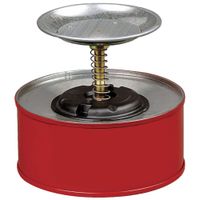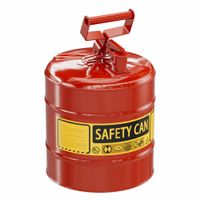Call +(254) 703 030 000 / 751 483 999 / 721 704 777
- Home
- Safety
- Safety Storage
- Safety Cans Tanks
.....Read More
Frequently Asked Questions
What is the difference between Type I and Type II safety cans?
Type I and Type II safety cans are both designed for the safe storage and handling of flammable liquids, but they have distinct differences in design and functionality:
1. **Design and Structure**:
- **Type I Safety Cans**: These cans have a single opening for both filling and pouring. This opening is typically equipped with a spout cover and a flame arrestor to prevent ignition of the contents. The user must remove the spout cover to pour or fill the can.
- **Type II Safety Cans**: These cans have two openings: one for filling and another for pouring. The pouring spout often includes a flexible metal hose, which allows for more controlled and precise pouring. The separate fill opening also has a flame arrestor.
2. **Ease of Use**:
- **Type I**: Requires the user to tilt the can to pour, which can be less precise and may increase the risk of spills.
- **Type II**: The flexible hose and separate openings make it easier to pour without spilling, providing better control and reducing the risk of accidents.
3. **Safety Features**:
- Both types include flame arrestors to prevent flashback ignition and are typically made of durable materials like galvanized steel or high-density polyethylene.
- Type II cans offer enhanced safety due to their design, which minimizes the risk of spills and exposure to flammable vapors.
4. **Applications**:
- **Type I**: Suitable for general use where precise pouring is not critical.
- **Type II**: Ideal for applications requiring precise pouring, such as filling small tanks or containers.
In summary, Type I safety cans are simpler with a single opening, while Type II cans offer more control and safety with separate openings for filling and pouring.
How do safety cans prevent accidents when storing flammable liquids?
Safety cans prevent accidents when storing flammable liquids through several key features. Firstly, they are constructed from materials that resist corrosion and are designed to contain the liquid securely, reducing the risk of leaks. The cans are equipped with a spring-closing lid and a spout cover, which automatically close after pouring, minimizing the chance of spills and exposure to air, thereby reducing the risk of ignition.
The flame arrestor is another critical component. It is a metal screen or mesh that dissipates heat and prevents external flames from reaching the liquid inside the can. This feature is crucial in preventing flashback ignition, where an external flame could ignite the vapors inside the can.
Safety cans are also designed to relieve internal pressure. In the event of a fire or exposure to high temperatures, the can's pressure-relief mechanism allows built-up vapors to escape safely, preventing the can from rupturing or exploding.
Additionally, safety cans are color-coded and labeled to identify the type of liquid stored, reducing the risk of misuse or accidental mixing of incompatible substances. Their ergonomic design, including a handle for easy carrying and pouring, ensures safe handling and reduces the risk of spills during transport.
Overall, these features work together to contain flammable liquids securely, prevent vapor release, and protect against ignition sources, significantly reducing the risk of fire and explosion in environments where flammable liquids are used or stored.
What materials are safety cans typically made from?
Safety cans are typically made from materials that ensure durability, chemical resistance, and safety in handling flammable or hazardous liquids. The most common materials used include:
1. **Galvanized Steel**: This is a popular choice due to its strength and durability. Galvanized steel safety cans are coated with a layer of zinc to prevent rust and corrosion, making them suitable for storing flammable liquids. They are often used in industrial settings where robust handling is required.
2. **Stainless Steel**: Known for its corrosion resistance and strength, stainless steel is used for safety cans that need to withstand harsh environments or store particularly corrosive substances. It is more expensive than galvanized steel but offers superior longevity and resistance to chemical reactions.
3. **Polyethylene**: This plastic material is lightweight and resistant to dents, punctures, and many chemicals. Polyethylene safety cans are ideal for storing corrosive liquids that might react with metal. They are often used in laboratories and environments where chemical compatibility is crucial.
4. **High-Density Polyethylene (HDPE)**: A variant of polyethylene, HDPE is known for its high strength-to-density ratio. It offers excellent chemical resistance and is used for safety cans that need to be both lightweight and durable.
5. **Brass and Aluminum**: These materials are less common but are used for specific applications where their unique properties are beneficial. Brass offers good corrosion resistance, while aluminum is lightweight and resistant to rust.
Safety cans made from these materials often feature additional safety features such as flame arresters, pressure relief mechanisms, and leak-proof seals to enhance their safety and functionality.
How should safety cans be maintained or repaired?
Safety cans should be maintained and repaired by following these guidelines:
1. **Regular Inspection**: Conduct routine checks for any signs of wear, damage, or corrosion. Inspect the lid, spout, and handle for functionality and integrity.
2. **Cleaning**: Clean the exterior and interior of the can regularly to prevent contamination and buildup of residues. Use appropriate cleaning agents that do not react with the can's material or its contents.
3. **Check Seals and Gaskets**: Ensure that seals and gaskets are intact and not cracked or worn out. Replace them if necessary to maintain a proper seal and prevent leaks.
4. **Test the Safety Mechanism**: Verify that the safety mechanism, such as the spring-closing lid and flame arrester, is functioning correctly. The lid should close automatically and securely.
5. **Repair Minor Damages**: For minor dents or scratches, use appropriate tools to repair them, ensuring the structural integrity of the can is not compromised.
6. **Replace Damaged Parts**: If any part of the can is severely damaged or cannot be repaired, replace it with parts from the original manufacturer to ensure compatibility and safety.
7. **Labeling**: Ensure that the can is properly labeled with the contents and any relevant safety information. Replace labels if they become unreadable.
8. **Storage**: Store safety cans in a cool, dry place away from direct sunlight and sources of ignition. Ensure they are stored upright and secured to prevent tipping.
9. **Compliance**: Follow manufacturer guidelines and local regulations for maintenance and repair. Ensure that any repairs do not void warranties or certifications.
10. **Professional Servicing**: For complex repairs or if unsure about the condition of the can, consult a professional or the manufacturer for servicing.
Regular maintenance and prompt repair of safety cans are crucial for ensuring safe storage and handling of hazardous materials.
What are the regulations for transporting flammable liquids in safety cans?
Regulations for transporting flammable liquids in safety cans are primarily governed by the U.S. Department of Transportation (DOT) and the Occupational Safety and Health Administration (OSHA).
1. **DOT Regulations**:
- **Packaging**: Flammable liquids must be transported in approved containers. Safety cans must meet DOT specifications, such as being made of metal or plastic, having a spring-closing lid, spout cover, and being designed to safely relieve internal pressure.
- **Labeling and Marking**: Containers must be properly labeled with the appropriate hazard class and identification number. Labels should be durable, in English, and clearly visible.
- **Quantity Limits**: There are specific quantity limits for transporting flammable liquids in safety cans, often not exceeding 5 gallons per can for most flammable liquids.
2. **OSHA Regulations**:
- **Design and Construction**: Safety cans must be designed to prevent spillage and control vapors. They should have a flame arrester to prevent ignition of contents.
- **Use and Maintenance**: Safety cans should be regularly inspected for damage or leaks. They must be used in accordance with OSHA standards to ensure workplace safety.
- **Storage**: When not in use, safety cans should be stored in a flammable storage cabinet or a designated safe area to minimize fire risks.
3. **General Safety Practices**:
- **Training**: Personnel involved in handling and transporting flammable liquids must be trained in proper safety procedures.
- **Emergency Procedures**: Emergency response plans should be in place in case of spills or accidents during transport.
These regulations ensure the safe and compliant transport of flammable liquids, minimizing risks to health, safety, and the environment.
How do dispensing cans work for solvents and cleaning fluids?
Dispensing cans for solvents and cleaning fluids are designed to safely store and dispense volatile or hazardous liquids. These cans typically feature a robust construction, often made from materials like stainless steel or high-density polyethylene, to resist corrosion and chemical reactions.
The primary mechanism involves a spring-loaded pump or spout. When the user presses down on the pump, it creates pressure that forces the liquid up through a tube and out of the spout. This design minimizes spills and reduces the risk of exposure to harmful vapors. The spout often has a narrow opening to allow for precise application, which is crucial when dealing with potent solvents.
Many dispensing cans include a flame arrestor, a safety feature that prevents external flames from igniting the contents of the can. This is particularly important for flammable solvents. The flame arrestor is typically a mesh screen that dissipates heat and prevents flames from traveling back into the can.
Some cans also have a self-closing lid or cap that automatically seals when not in use, further reducing the risk of spills and evaporation. This feature is essential for maintaining the integrity of the solvent and ensuring user safety.
Additionally, these cans often have a venting system to equalize pressure inside the can, preventing vacuum formation that could impede the flow of liquid. This venting system is usually designed to prevent the release of harmful vapors into the environment.
Overall, dispensing cans are engineered to provide a controlled, safe, and efficient way to handle solvents and cleaning fluids, prioritizing user safety and environmental protection.
What are the best practices for using tanks for surface and parts cleaning?
1. **Material Compatibility**: Ensure the tank material is compatible with the cleaning solution to prevent corrosion or degradation.
2. **Proper Sizing**: Select a tank size that accommodates the parts being cleaned without overcrowding, allowing for effective cleaning action.
3. **Solution Selection**: Use appropriate cleaning solutions for the contaminants and materials involved. Consider factors like pH, temperature, and chemical composition.
4. **Temperature Control**: Maintain optimal temperature for the cleaning solution to enhance cleaning efficiency without damaging parts.
5. **Agitation**: Implement mechanical or ultrasonic agitation to improve cleaning action by dislodging contaminants.
6. **Filtration and Recirculation**: Use filtration systems to remove particulates from the cleaning solution, extending its life and maintaining effectiveness.
7. **Rinsing**: Incorporate a rinsing stage to remove residual cleaning agents, preventing surface damage or contamination.
8. **Drying**: Ensure thorough drying of parts post-cleaning to prevent corrosion or water spots.
9. **Regular Maintenance**: Schedule regular maintenance and cleaning of tanks to prevent buildup of residues and ensure consistent performance.
10. **Safety Measures**: Implement safety protocols, including proper ventilation, personal protective equipment (PPE), and spill containment.
11. **Environmental Compliance**: Adhere to environmental regulations regarding disposal of cleaning solutions and waste management.
12. **Training**: Provide comprehensive training for personnel on operating procedures, safety measures, and emergency protocols.
13. **Monitoring and Testing**: Regularly monitor and test the cleaning solution for concentration and contamination levels to maintain effectiveness.
14. **Documentation**: Keep detailed records of cleaning processes, maintenance, and inspections for quality control and compliance purposes.



